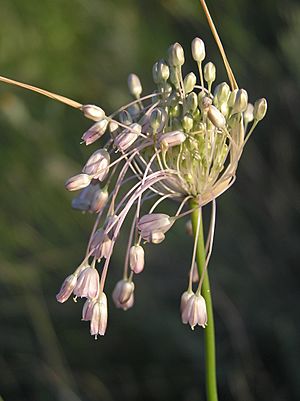Mediterranean onion facts for kids
Allium paniculatum, also known as the Mediterranean onion or pale garlic, is a type of wild onion plant. It is found naturally in many parts of Europe and Asia, especially around the Black Sea and Mediterranean Sea. This plant is also grown in many places and has spread to new areas like California and New York in the United States.
Quick facts for kids Mediterranean onion |
|
|---|---|
 |
|
| Scientific classification |
Contents
What Does the Mediterranean Onion Look Like?
The Mediterranean onion grows several egg-shaped bulbs, each about 1.5 centimeters (about half an inch) wide. It does not have underground stems called rhizomes. Its leaves are like hollow tubes and can grow up to 35 centimeters (about 14 inches) long.
The main stem, called a scape, is round and solid. It can reach up to 75 centimeters (about 30 inches) tall. Even though its name sounds like "panicle" (a type of flower cluster), its flowers grow in a round cluster called an umbel. This cluster can have as many as 100 bell-shaped flowers! Each flower is about 6 millimeters (a quarter of an inch) wide. The flower petals, called tepals, can be white or a light purple color, like lilac. The pollen and the parts that hold it, called anthers, are yellow.
How Scientists Classify This Plant
Scientists place Allium paniculatum in a group called section Codonoprasum, which is part of the larger group subgenus Allium. For a long time, scientists thought this plant was very changeable. They included many different types of plants under its name. Now, many of those types are seen as their own separate species. Some examples include Allium dentiferum, A. fuscum, A. oleraceum, A. pallens, and A. tenuiflorum.
Because of this, it was hard to know exactly what the plant looked like everywhere. It was also hard to know its true natural home. For example, people used to think it grew all over Europe, the Middle East, and North Africa. However, studies show that the original plant type came from Ukraine and southern Russia.
Scientists use phylogenetics to study how plants are related. This helps them understand the plant's family tree. Allium paniculatum is closely related to three other species: A. oleraceum, A. savii, and A. telmatum. These four species form a smaller group within their section.
Where Does the Mediterranean Onion Grow?
The Mediterranean onion has been reported in many places. This includes every European country that touches the Black and Mediterranean Seas. It also grows on islands like Corsica, Sardinia, Sicily, and Crete. It is also native to countries like Portugal, the Czech Republic, Hungary, Kazakhstan, Armenia, Georgia, Azerbaijan, Iran, Iraq, Lebanon, Syria, Israel, and Palestine.
It has also started to grow naturally in new places. These include California, New York State, the Azores, Madeira, the Canary Islands, and South Australia.
However, as mentioned before, newer studies suggest its true native home is mainly in Ukraine and southern Russia. The plant has been found near the San Francisco Bay in California. It has also been seen in a few spots in Essex County in northeastern New York State. This is something to watch out for. This plant can grow very quickly in places where the ground has been disturbed, like along roadsides or in farm fields. It has the potential to become a plant that spreads too much and causes problems for other plants.
Images for kids
See also
 In Spanish: Ajillo de monte para niños
In Spanish: Ajillo de monte para niños


